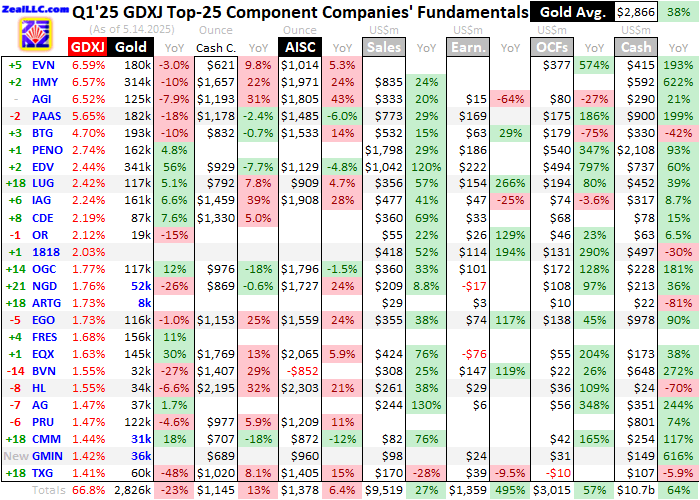Gold Mid-Tiers’ Q1’25 Fundamentals
The mid-tier and junior gold miners in this sector’s sweet spot for upside potential just achieved their best quarter ever. Profits soared to amazing records, fueled by record gold prices combined with mostly holding the line on costs. The fundamentally-superior smaller gold miners continue to outperform the majors, and remain deeply undervalued relative to prevailing gold. Their stocks need to mean revert far higher.
The leading mid-tier-gold-stock benchmark is the GDXJ VanEck Junior Gold Miners ETF. With $5.2b in net assets mid-week, it remains the second-largest gold-stock ETF after its big-brother GDX. That is dominated by far-larger major gold miners, though there is much overlap between these ETFs’ holdings. Still misleadingly named, GDXJ is overwhelmingly a mid-tier gold-stock ETF with juniors having little weighting.
Gold-stock tiers are defined by miners’ annual production rates in ounces of gold. Small juniors have little sub-300k outputs, medium mid-tiers run 300k to 1,000k, large majors yield over 1,000k, and huge super-majors operate at vast scales exceeding 2,000k. Translated into quarterly terms, these thresholds shake out under 75k, 75k to 250k, 250k+, and 500k+. Today only four of GDXJ’s 25 biggest holdings are true juniors!
Their Q1 outputs are highlighted in blue in the table below. Juniors not only mine less than 75k ounces per quarter, but gold output generates over half their quarterly revenues. That excludes streaming and royalty companies that purchase future gold output for big upfront payments used to finance mine-builds, and primary silver miners producing byproduct gold. But mid-tiers often make better investments than juniors.
These gold miners dominating GDXJ offer a unique mix of sizable diversified production, excellent output-growth potential, and smaller market capitalizations ideal for outsized gains. Mid-tiers are less-risky than juniors, while amplifying gold uplegs more than majors. So we’ve long specialized in the fundamentally-superior mid-tiers and juniors at Zeal, actively trading these smaller gold miners for a quarter-century now.
While GDXJ powered 111.3% higher over 18.4 months into mid-April, smaller gold miners have really underperformed. That reflects anemic trader interest in this sector. The GDX majors rallied up a similar 100.3% in this span, so the smaller gold miners should’ve fared much better. During big gold uplegs, it’s not uncommon for excellent mid-tiers and juniors to enjoy huge stock-price gains roughly doubling GDX’s!
The smaller gold miners are firing on all cylinders operationally, their stocks’ underperformance certainly hasn’t been fundamentally-driven. The gold miners have simply languished in indifference despite gold’s massive cyclical bull. Over 19.0 months from early October 2023 to early May 2025, gold soared 88.1% higher without a single 10%+ correction! GDX’s gains at best within that only leveraged gold a pathetic 1.1x.
Historically the major gold stocks of GDX tend to amplify material gold moves by 2x to 3x. During gold’s last 40%+ monster upleg cresting in early August 2020, GDX soared 134.1% leveraging gold by a great 3.4x! GDXJ really outperformed in that span, skyrocketing 188.9% for 4.7x upside! Given smaller gold miners’ epic record fundamentals, big outperformance is still coming as investors rediscover this sector.
For 36 quarters in a row now, I’ve painstakingly analyzed the latest operational and financial results from GDXJ’s 25-largest component stocks. Mostly mid-tiers, they now account for 66.8% of this ETF’s total weighting. While digging through quarterlies is a ton of work, understanding smaller gold miners’ latest fundamentals really cuts through the obscuring sentiment fogs shrouding this sector. This research is essential.
This table summarizes the GDXJ top 25’s operational and financial highlights during Q1’25. These gold miners’ stock symbols aren’t all US listings, and are preceded by their rankings changes within GDXJ over this past year. The shuffling in their ETF weightings reflects shifting market caps, which reveal both outperformers and underperformers since Q1’24. Those symbols are followed by their recent GDXJ weightings.
Next comes these gold miners’ Q1’25 production in ounces, along with their year-over-year changes from the comparable Q1’24. Output is the lifeblood of this industry, with investors generally prizing production growth above everything else. After are the costs of wresting that gold from the bowels of the earth in per-ounce terms, both cash costs and all-in sustaining costs. The latter help illuminate miners’ profitability.
That’s followed by a bunch of hard accounting data reported to securities regulators, quarterly revenues, earnings, operating cash flows, and resulting cash treasuries. Blank data fields mean companies hadn’t disclosed that particular data as of the middle of this week. The annual changes aren’t included if they would be misleading, like comparing negative numbers or data shifting from positive to negative or vice-versa.
With last quarter’s average gold price blasting up 38.3% YoY to a stunning record $2,866, gold miners’ Q1’25 results had to be awesome. The GDXJ mid-tiers certainly didn’t disappoint, achieving their best quarter in history by far! That was no flash in the pan either, as the smaller gold miners have reported exploding profits for many consecutive quarters now. Their ongoing fundamental strength is unmatched.
While GDXJ has gradually evolved into the best gold-stock ETF, it has seen jarring composition changes along the way. I’ve analyzed plenty of those in my dozens of previous essays in this long research thread. For many years, GDXJ included more majors and even super-majors that belonged exclusively in GDX. GDXJ’s managers had reasons for doing that, but larger gold miners have really distorted GDXJ’s history.
Further complicating comparisons these larger gold miners were usually foreign, reporting in half-years instead of quarters. So they only released results to be included and analyzed every-other quarter. And some have been very inconsistent in what they report, particularly the Chinese gold miners. That’s the case last quarter with Zhaojin Mining, which published some financial statements but no gold output data.
A year ago in the comparable Q1’24, this company reported mining a colossal 514k ounces of gold which gave it super-major status! Q1’25’s production was probably similar, but I couldn’t find it anywhere. Also in Q1’24, a second super-major Kinross Gold was GDXJ’s top holding producing another 527k ounces! Thankfully over this past year Kinross has been booted from GDXJ, now remaining in GDX where it belongs.
In raw terms, the GDXJ top 25’s collective gold production of 2,826k ounces plunged 23.5% YoY which sounds ugly. But if Zhaojin’s and Kinross’s massive outputs now not reported or included in Q1’25’s total are excluded from Q1’24, and instead replaced by GDXJ’s then-26th-and-27th-largest components’, mid-tiers’ aggregate production merely slipped 1.4% YoY. That’s right in line with the gold-mining industry as a whole.
The World Gold Council publishes the best-available global gold supply-and-demand data quarterly in its outstanding Gold Demand Trends reports. The Q1’25 edition reported overall world gold-mining output edged up 0.3% YoY then. The GDXJ top 25’s production would’ve actually grown if not for composition changes. Over this past year, an unusual number of mid-tiers and juniors soared into GDXJ’s upper ranks.
Both GDXJ and GDX effectively weight their components by market capitalization, so gold stocks being bid higher faster than their peers climb these rankings. New GDXJ-top-25 stocks since Q1’24 include Lundin Gold, OceanaGold, New Gold, Artemis Gold, Capricorn Metals, G Mining Ventures, and Torex Gold! I know all these stocks well, and have traded all but one of these good-to-excellent smaller gold miners.
But that’s still a lot of churn for comparability’s sake, with over a quarter of GDXJ’s top-25 components being new. Highlighting one, Artemis Gold has certainly had the biggest transformation of all. A year ago it was a late-stage explorer constructing a great new gold mine, which just went commercial in early May. That 8k ounces yielded in Q1’25 came before that, and output will quickly ramp higher in coming quarters.
Artemis is forecasting 2025 midpoint production of 210k ounces, climbing to this mine’s projected annual average run rate of 321k in its first five years of operations! This recent explorer is rapidly transforming into a junior then a mid-tier in a single year. Naturally its growing output will boost the GDXJ top 25’s total in coming quarters. Torex Gold is another interesting production case, its output plummeting 48.4% YoY in Q1!
That was the worst by far among the entire GDXJ top 25, looking dismal. But last quarter was a unique transition one for Torex, which was tying in transport infrastructure from a new gold deposit to its mine’s existing processing plant. Fascinatingly that includes an underground conveyor system running through a recently-bored 4.3-mile tunnel! Torex had to shut down processing for a month in Q1’25 to integrate that in.
So despite Q1’s mere 60k ounces mined which was planned, this company is on track to hit its full-year midpoint guidance of 425k ounces. Some other GDXJ-top-25 miners also have new mines or expansions ramping up. The point is mid-tiers’ and juniors’ production is much stronger than last quarter’s total suggests. Coming quarters will see big year-over-year growth as these projects gradually ramp to designed speed.
Unit gold-mining costs are generally inversely proportional to gold-production levels. That’s because gold mines’ total operating costs are largely fixed during pre-construction planning stages, when designed throughputs are determined for plants processing gold-bearing ores. Their nameplate capacities don’t change quarter to quarter, requiring similar levels of infrastructure, equipment, and employees to keep running.
So the primary variable driving quarterly gold production is the ore grades fed into these plants. Those vary widely even within individual gold deposits. Richer ores yield more ounces to spread mining’s big fixed expenses across, lowering unit costs and boosting profitability. But while fixed costs are the lion’s share of gold mining, there are also sizable variable costs. That’s where recent years’ raging inflation hit hard.
Cash costs are the classic measure of gold-mining costs, including all cash expenses necessary to mine each ounce of gold. But they are misleading as a true cost measure, excluding the big capital needed to explore for gold deposits and build mines. So cash costs are best viewed as survivability acid-test levels for smaller gold miners. They illuminate the minimum gold prices necessary to keep the mines running.
In Q1’25 the GDXJ top 25’s average cash costs surged 13.2% YoY to a record $1,145 per ounce. While high, those are still far below prevailing gold prices. And like usual those were skewed by an outlier. High-cost producer Hecla Mining’s cash costs soared 31.5% YoY to a whopping $2,195 last quarter! But its 2025 guidance’s midpoint is a much-better $1,575. Excluding Hecla, the GDXJ-top-25 average was $1,087.
All-in sustaining costs are far superior than cash costs, and were introduced by the World Gold Council in June 2013. They add on to cash costs everything else that is necessary to maintain and replenish gold-mining operations at current output tempos. AISCs give a much-better understanding of what it really costs to maintain gold mines as ongoing concerns, and reveal smaller gold miners’ true operating profitability.
AISCs generally follow cash costs, which are AISCs’ largest component by far. Yet in Q1’25 the GDXJ-top-25’s average all-in sustaining costs merely climbed 6.4% YoY to $1,378 per ounce. That’s way under their record $1,442 seen back in Q4’22, and even better than the GDX-top-25 majors’ $1,396 average last quarter! I analyzed larger gold miners’ Q1’25 results in last week’s essay if you want to compare them.
Again Hecla’s super-high $2,303 AISCs skewed that average high, without it the rest of these elite mid-tier and junior gold miners averaged just $1,323 AISCs. Hecla is also forecasting considerably-better AISCs, with 2025’s midpoint at $1,850. But on the extreme opposite end of the mining-cost spectrum, Peruvian polymetallic miner Buenaventura’s huge byproduct credits forced its gold AISCs deeply negative to -$852!
Despite only 29% of its Q1’25 revenues coming from gold, this company reports in gold-centric terms as gold miners command higher valuations than base-metals miners. Buenaventura produces lots of silver, zinc, and lead declared byproducts. Negative gold AISCs are nothing new for this miner, as in Q1, Q2, and Q3 last year they ran -$121, -$578, and -$680. Ex-Buenaventura, the GDXJ top 25 averaged $1,509 in Q1’25.
Yet those extreme negative AISCs still have to be included in averages for consistency’s sake. During the 36 quarters of this research thread, there have been plenty of extreme-high-AISC outliers for various reasons dragging up the GDXJ-top-25 averages. Every quarter all reported AISCs were always included for analysis, no matter how anomalous or how much they skewed things. Buenaventura’s are treated the same.
With GDXJ-top-25 average AISCs merely climbing 6.4% YoY to $1,378 while Q1’25’s average gold prices skyrocketed 38.3% YoY to $2,866, the smaller gold miners had to be making money hand over fist. The best proxy for sector profitability simply subtracts the former from the latter. These implied unit earnings are cleaner than bottom-line accounting profits, which are usually distorted by unusual noncash losses or gains.
Astoundingly these elite mid-tiers earned a dazzling record $1,488 per ounce last quarter! That’s better than the GDX-top-25 majors’ $1,470, despite the bigger gold miners’ supposed economies of scale. And that stellar $1,488 from the GDXJ top 25 skyrocketed 91.5% YoY! Achieving doubling profits would be phenomenal for any stock-market sector in any quarter, yet this is the latest in smaller gold miners’ long streak.
Starting fully seven quarters ago in Q3’23, the GDXJ top 25’s implied unit earnings soared an epic 106%, 133%, 63%, 66%, 71%, 95%, and 91% YoY! This is wildly unrivaled across the entire stock markets, so speculators and investors ought to be flocking to smaller gold stocks. Odds are they still rediscover this high-flying contrarian sector sooner or later, flooding in to chase big gains really accelerating GDXJ’s upside.
The smaller gold miners’ extraordinary run of epic fundamental strength isn’t over yet either. Quarter-to-date so far in this current Q2, gold is already averaging $3,244 which is another staggering 38.8% above Q2’24 levels! Even if gold rolls over into an overdue correction after getting crazy-overbought in mid-April, Q2’25’s average gold prices will be way higher. And the GDXJ top 25 are forecasting lower mining costs.
As analyzed in my GDX-top-25 essay last week, Q1s are the weakest production quarters for gold miners primarily due to northern-hemisphere winters adversely impacting mining operations. According to the World Gold Council, since Q1’11 global mined gold output in Q1s, Q2s, Q3s, and Q4s has averaged big quarter-on-quarter swings of -8.9%, +4.7%, +6.5%, and +0.6%! So AISCs retreat through calendar years.
Indeed the GDXJ top 25’s average full-year-2025 midpoint guidance for AISCs ran $1,348 per ounce, including Q1’s $1,378. If these elite smaller gold miners’ Q2’25 AISCs come in close to that forecast, and gold mostly consolidates high remaining near its quarter-to-date average, GDXJ-top-25 implied unit earnings could soar another 75%ish YoY near $1,900 per ounce! Holy cow the getting is good in this sector.
Last quarter’s hard accounting results reported to securities regulators confirmed how epic smaller gold miners’ Q1’25 proved. The GDXJ top 25’s collective revenues surged 26.8% YoY to $9,519m. That is well under Q4’24’s record $11,193m, but only because of foreign gold miners’ half-year reporting. That inflates Q2 and Q4 totals when half-year numbers are released, but there’s no data to halve for Q1s and Q3s.
The smaller gold miners’ bottom-line profits skyrocketed a spectacular 494.5% YoY to $1,359m! And that insane sextupling followed 353%- and 305%-YoY growth in the prior two quarters. Without unusual items flushed through a handful of income statements, GDXJ-top-25 earnings would’ve been even higher last quarter. Several miners reported big unrealized losses on derivatives slashing $232m off of total earnings.
Hedging is the scourge of gold-mining shareholders, selling away gold’s upside which really hurt in such a strong gold quarter. These contracts locking in gold selling prices in coming quarters inflict serious losses during big bull runs. As an example, Australia’s Perseus Mining has forward sold about 24% of its next three years’ output at an average gold price of just US$2,375 per ounce! Gold-stock shareholders loathe hedges.
The GDXJ top 25’s cashflows generated from operations surged 57.1% YoY to $3,015m in Q1’25. Those gains would’ve been far bigger if not for a colossal unusual item in the comparable Q1’24. Then B2Gold forward sold 265k ozs of gold from July 2025 to June 2026 adding $500m in operating cashflows. But locking in all that gold at just $2,191 per ounce was sure foolish in hindsight, though it’s only 10% of output.
Strong operating cashflows are essential to fund future production growth, financing mine expansions, builds, and purchases. As these elite mid-tiers and juniors plow their cash windfalls into growing output, they are laying foundations for even-larger future profits. Those fat OCFs catapulted the GDXJ top 25’s cash treasuries up 64.3% YoY to $10,725m. That’s a record warchest even above past super-major quarters’!
With all that cash burning holes in miners’ pockets, a big wave of mergers and acquisitions is coming. It is way easier to buy an existing mine than building a new one, as that long process from exploring to proving out reserves through drilling to securing permitting to constructing a new mine takes a decade or more. While expensive, buying existing mines can bring in big production growth in just a matter of months.
Despite the smaller gold miners’ epic record quarter, I’d be wary of chasing them now. Gold is still likely to suffer a 10%+ correction after recent crazy-overboughtness, which the major gold stocks will leverage by 2x to 3x and the mid-tiers and juniors even more. So a buying opportunity at considerably-lower prices is coming. Only 3% off highs midweek, if gold falls another 10% the gold stocks could drop another 20% to 30%+.
Our upcoming newsletters will continue to analyze all these timing and price-level considerations in real-time, adapting our redeployment into great hand-picked fundamentally-superior high-potential smaller gold miners as we go. If you don’t want to miss that and our resulting specific gold-stock trades, please subscribe to our newsletters and support our research work. The ideal gold-stock buying window could be short.
Successful trading demands always staying informed on markets, to understand opportunities as they arise. We can help! For decades we’ve published popular weekly and monthly newsletters focused on contrarian speculation and investment. They draw on my vast experience, knowledge, wisdom, and ongoing research to explain what’s going on in the markets, why, and how to trade them with specific stocks.
Our holistic integrated contrarian approach has proven very successful, and you can reap the benefits for only $10 an issue. We extensively research gold and silver miners to find cheap fundamentally-superior mid-tiers and juniors with outsized upside potential. Sign up for free e-mail notifications when we publish new content. Even better, subscribe today to our acclaimed newsletters and start growing smarter and richer!
The bottom line is smaller mid-tier and junior gold miners just reported their best quarter in history by far. They largely held the line on mining costs, which actually proved lower than the majors’. Combined with record gold prices, that fueled smaller gold miners’ richest-and-fattest earnings ever witnessed. Implied unit profits have now skyrocketed with mostly-high-double-digit annual gains for an epic seven quarters in a row!
This unparalleled hyper-bullish streak will persist in this current mostly-over quarter, which is on track to achieve another big record. The fundamentally-superior smaller gold miners are earning money hand-over-fist, yet their stock prices are still languishing. Thus a massive mean-reversion higher is overdue and inevitable. Mid-tier and junior gold stocks still have to multiply from here to reflect prevailing gold levels.
********
















